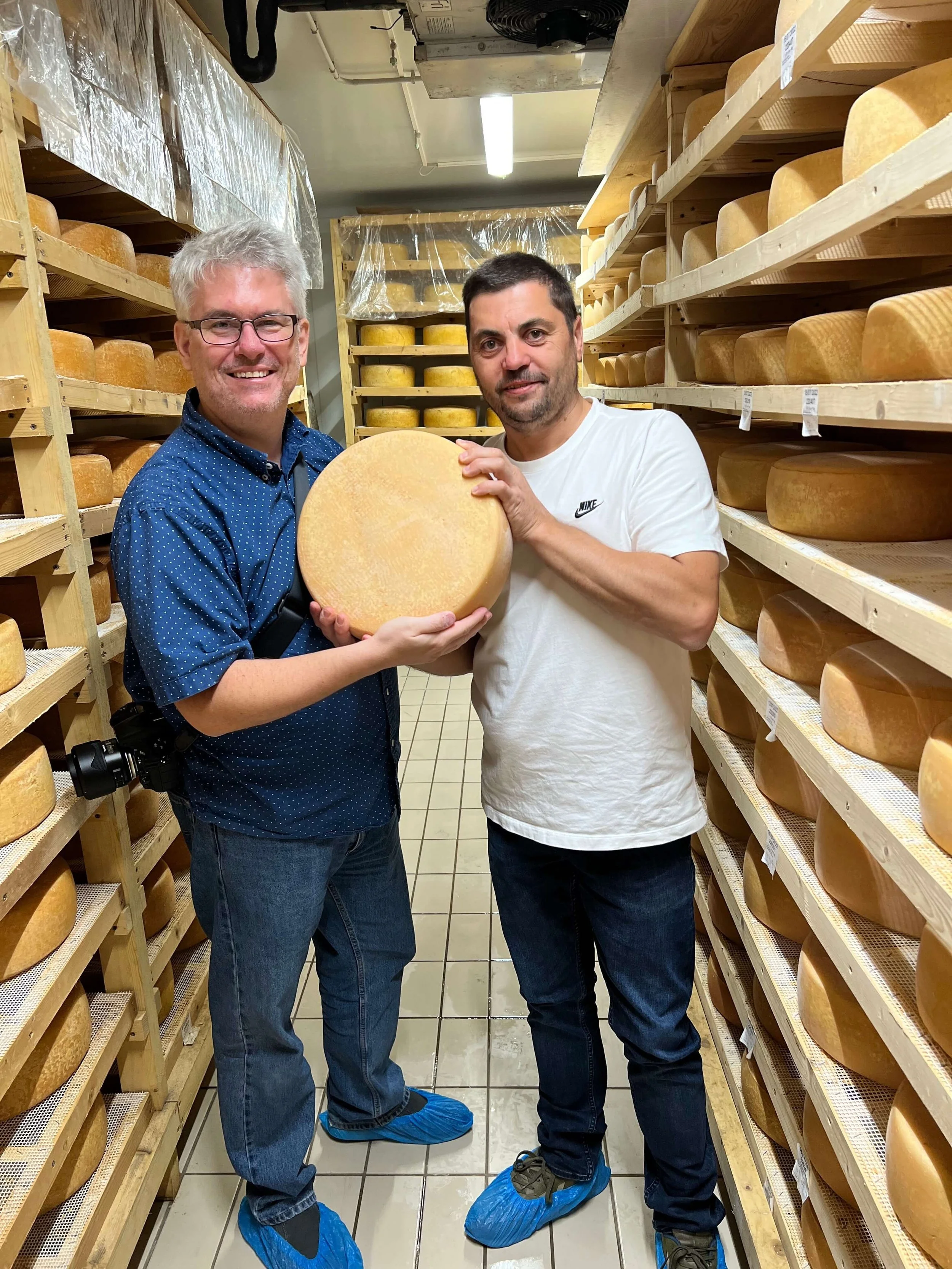Producers We Love: Formatges Sant Gil d’Albió, Catalunya, Spain
In the heart of Spain’s Catalunya region, the country’s most famous goat cheese is made. Of the handful of producers making Garrotxa, only one family has made a version of it from nearly the very beginning. A traditional cheese, it had practically disappeared before being revived in the 1980s by a local dairy cooperative.
Me with Josep in his aging cave.
Josep Martí owns and operates Sant Gil d’Albió, a tiny dairy producer in the foothills of Northern Spain. The formatgeria has been in the same spot for more than four decades, the family home he was born in. The top floors were converted into a cheese processing space in 1981. While Josep now lives fifteen minutes away, he returns to his childhood home every day to continue the family business making cheese. Josep learned cheesemaking from his mother, who still lives there with his sister.
Where is Formatgeria Sant Gil?
Formatgeria Sant Gil is located in Albió, a small village found 75 miles west of Barcelona. The drive there takes you past the saw-toothed Montserrat mountains, home to a Benedictine Abbey and at one time, the Holy Grail.
Once past the craggy mountain range, the landscape becomes less colorful and dramatic, flattening out until a few miles outside Albió, when broad hills and green fields gently rise to a higher altitude. The view from the village center spans the verdant Vall del Corb, a valley running through the area carved out by the Corb River.
Vall del Corb, España
Albió is small. Very small. With a population of 20 people, it doesn’t take long to meet everyone, especially since nearly half are related to Josep. The homes in the area were built using the bricks of nearby castles constructed by Muslims and Christians during the Middle Ages, remnants of religious encroachment dismantled and repurposed by locals. Ruddy and strong, they line the narrow street that spans the short length of the village.
Garrotxa
Formatgeria Sant Gil is one of only 10 dairies making Garrotxa, arguably the most iconic cheese made in all of Catalonia. Originally called Pell Florida, “skin flor”, for the distinct rind development that occurs during maturation, the name was changed around 1980 to take on the name of a village in the region as a way to bolster authenticity.
Made from pasteurized Murciana goat milk, the two-pound wheels are aged for up to six weeks. The exterior of the cheese often resembles a smooth stone, while the interior is uniformly white with a soft texture and a mellow, delicate flavor.
Martí doesn’t own or care for any goats himself. He buys pasteurized goat milk from regional farms, some as far as two hours north in the Pyrénées, where the animals graze on alfalfa. This strategy was implemented by his father 35 years ago as a way to keep the focus on cheesemaking, and Martí sees no reason to change.
Other Cheeses Made at Formatgeria Sant Gil
In addition to Garrotxa, Formatgeria Sant Gil also makes Gotes Catalanes, small spheres that resemble tiny mozzarella balls. The name translates to “Catalan drops” and is an original creation. Made with rich, full-fat goat’s milk using lactic fermentation, the cheese is mixed with garlic and parsley, hand-rolled, and then preserved in sunflower oil. The creamy, melt-in-your-mouth texture and smooth flavor make them perfect for tapas and salads, or to eat right out of the jar.
Martí also makes a range of semi-firm and firm goat cheeses and even offers a cow’s milk cheese made with milk from a friend’s herd. His newest cheese is El Gran Pep. Sold only from February until July, it was created to prevent surplus goat milk produced at the height of the milking season from going to waste.
The recipe is a result of more than a decade of research and development. “Make, taste, fix. Repeat.”, Martí says with a sense of resignation. In the beginning, they had significant issues with cheese mites creating holes in the rind, a source of bemusement for Martí and his team. “The wheels looked like giant Mimolette!”, he chuckles, throwing his hands in the air.
To solve the problem, they took a cue from Swiss Gruyère producers and started washing the rinds to stifle cheese mite growth. The tactic worked perfectly, allowing the wheels to age between nine and twelve months in Martí’s maturation cellars. The team still keeps a keen eye on any potential problems, analyzing the aging batches each week and taking action if needed.
With plans for growth and expansion, Martí is optimistic about the future. “Catalan cheese culture is in its adolescence,” he says energetically. “We are making all sizes and styles of cheeses now. Wheels are big, small, soft, and even blue cheese. And, good blue, too!”
This story was written for and appears on www.cheeseprofessor.com.


